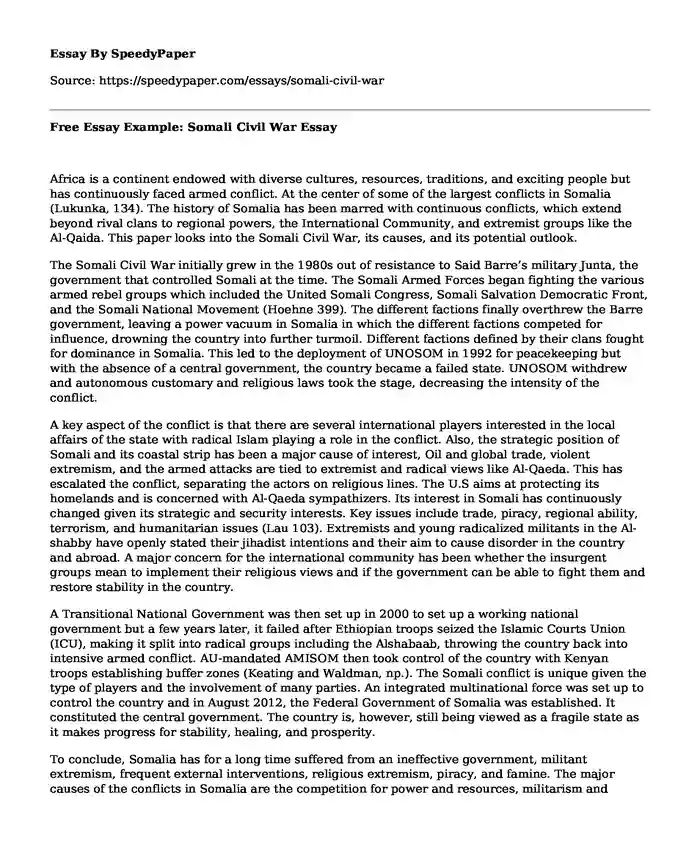Africa is a continent endowed with diverse cultures, resources, traditions, and exciting people but has continuously faced armed conflict. At the center of some of the largest conflicts in Somalia (Lukunka, 134). The history of Somalia has been marred with continuous conflicts, which extend beyond rival clans to regional powers, the International Community, and extremist groups like the Al-Qaida. This paper looks into the Somali Civil War, its causes, and its potential outlook.
The Somali Civil War initially grew in the 1980s out of resistance to Said Barre’s military Junta, the government that controlled Somali at the time. The Somali Armed Forces began fighting the various armed rebel groups which included the United Somali Congress, Somali Salvation Democratic Front, and the Somali National Movement (Hoehne 399). The different factions finally overthrew the Barre government, leaving a power vacuum in Somalia in which the different factions competed for influence, drowning the country into further turmoil. Different factions defined by their clans fought for dominance in Somalia. This led to the deployment of UNOSOM in 1992 for peacekeeping but with the absence of a central government, the country became a failed state. UNOSOM withdrew and autonomous customary and religious laws took the stage, decreasing the intensity of the conflict.
A key aspect of the conflict is that there are several international players interested in the local affairs of the state with radical Islam playing a role in the conflict. Also, the strategic position of Somali and its coastal strip has been a major cause of interest, Oil and global trade, violent extremism, and the armed attacks are tied to extremist and radical views like Al-Qaeda. This has escalated the conflict, separating the actors on religious lines. The U.S aims at protecting its homelands and is concerned with Al-Qaeda sympathizers. Its interest in Somali has continuously changed given its strategic and security interests. Key issues include trade, piracy, regional ability, terrorism, and humanitarian issues (Lau 103). Extremists and young radicalized militants in the Al-shabby have openly stated their jihadist intentions and their aim to cause disorder in the country and abroad. A major concern for the international community has been whether the insurgent groups mean to implement their religious views and if the government can be able to fight them and restore stability in the country.
A Transitional National Government was then set up in 2000 to set up a working national government but a few years later, it failed after Ethiopian troops seized the Islamic Courts Union (ICU), making it split into radical groups including the Alshabaab, throwing the country back into intensive armed conflict. AU-mandated AMISOM then took control of the country with Kenyan troops establishing buffer zones (Keating and Waldman, np.). The Somali conflict is unique given the type of players and the involvement of many parties. An integrated multinational force was set up to control the country and in August 2012, the Federal Government of Somalia was established. It constituted the central government. The country is, however, still being viewed as a fragile state as it makes progress for stability, healing, and prosperity.
To conclude, Somalia has for a long time suffered from an ineffective government, militant extremism, frequent external interventions, religious extremism, piracy, and famine. The major causes of the conflicts in Somalia are the competition for power and resources, militarism and repression by the regimes, and colonial history. However, these were exacerbated by the politicization of clan identities, religious radicalization, unemployed youth, and availability of weapons. There is a need to adopt ambitious peace strategies as well as solutions for good governance, economic prosperity, and inclusivity in the country.
Works Cited
Hoehne, Markus V. "Political identity, emerging state structures and conflict in northern Somalia." The Journal of Modern African Studies 44.3 (2006): 397-414.
Keating, Michael, and Matt Waldman, eds. War and peace in Somalia: national grievances, local conflict, and Al-Shabaab. Oxford University Press, 2019.
Lau, Raymond Kwun Sun. "Getting Beyond the Somalia Syndrome? Revisiting the United States’ Intervention." Reimagining Justice, Human Rights and Leadership in Africa: Challenging Discourse and Searching for Alternative Paths (2019): 103.
Lukunka, Barbra. "New big men: Refugee emasculation as a human security issue." International Migration 50.5 (2012): 130-141.
Cite this page
Free Essay Example: Somali Civil War. (2023, Aug 24). Retrieved from https://speedypaper.net/essays/somali-civil-war
Request Removal
If you are the original author of this essay and no longer wish to have it published on the SpeedyPaper website, please click below to request its removal:
- Free Essay: Diary of a Pilot During World War I
- Essay Sample on Eviction of Tenants in Utah
- Free Essay on Intercultural Communication in Singapore
- Free Essay Example: Embroidery
- Free Essay: Mental Health a Major Concern Among the Youth Today
- Free Essay: Significance of the Project of Ecotourism in the Region
- Witch Hunts and the Beginning of the Sexual Division of Labor in Sylvia Federici's Text - Essay Sample
Popular categories





